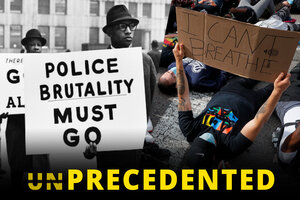Violent racism: Can Floyd protests break an old cycle?

It was an act of violence so visceral that when the public saw what had been done, the outrage came in a wave.
We’re referring, of course, to George Floyd dying under the knee of a Minneapolis police officer in May. The bystander video that captured his death has triggered some of the biggest racial justice protests in recent years.
But we could be talking about the beating of Rodney King by Los Angeles police officers in 1991, which was also caught on tape. The footage, coupled with the acquittal of the officers involved, led to rioting across LA in 1992. Or we could be citing the lynching of Emmett Till, a Chicago teenager who was brutally beaten to death in Mississippi in 1955 for allegedly whistling at a white woman (an accusation that was eventually recanted). The photo of his disfigured face was one of the sparks that ignited the civil rights movement.
Why We Wrote This
The death of George Floyd at the hands of law enforcement has launched a wave of calls against police brutality and forced the United States to again confront its history of racism. But violence against Black communities has fueled racial justice protests – and calls for change – for decades. This installment of our video series “Precedented” looks at where those past efforts succeeded, where they fell short, and what it might take to break the cycle.
In this episode of “Precedented,” we look at the cycles of racial violence, protest, and limited progress that marks 20th- and 21st-century America. What lessons should we be learning from this history? And what will it take to keep moving us forward?
“If history has repeated itself and where we are is very familiar, then maybe ... a new direction is in order,” says Frederick W. Gooding, assistant professor of African American studies at Texas Christian University in Fort Worth. “Not necessarily a revolution, but maybe revolutionary thought.”
You can find other episodes of the series here.

